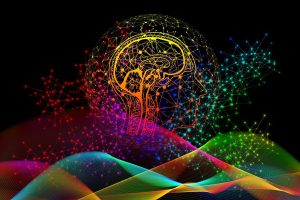Storytelling as sense-making
Let’s consider this relationship between ‘storytelling’ and ‘information’ in another context. You’ve no doubt heard of data journalism: a type of journalism where data (facts, statistics, and pieces of information) are used to find, generate, or evidence a news story. The term is often associated with increased public access to large datasets. Data journalism can allow journalists to go beyond the limits of traditional news production and represent ideas that are difficult to articulate in words or images alone, helping them tell stories about big, complex issues.

Image by Gerd Altmann from Pixabay. We are surrounded by data – can it be a tool for storytelling? What stories are “baked into” the data? (Gray and Bounegru 2021)
However, data is not a means by which journalists simply “reveal” information to audiences. And it’s important to remember that the data itself is not the story. Often, journalists will look for patterns in the data in order to tell a story, and/or they will combine data with other news-making techniques like interviews with real people who can help them put a “human face” on the issue.
At the same time, a good journalist will handle data with their critical thinking switched on – they will be wary of any implicit stories the data seems to tell. As Jonathon Gray and Liliana Bounegru note in their introduction to The Data Journalism Handbook, “Data does not just provide neutral and straightforward representations of the world, but is rather entangled with politics and culture, money and power” – consequently, journalists should consider what ideologies or misconceptions are “baked into” the data (Gray and Bounegru 2021).
This is important. Whether we are thinking about data journalism, advertising, or science communication – or something else – narrative is not just a technique for engaging your audience, it is also a way of organising meaning according to particular worldviews. When stories are told, power is enacted. So the dataset a journalist is working with may privilege some perspectives and marginalise others, while the representations of “family” in an ad campaign like that from Qantas (in the previous section) will normalise particular relationships, ways of being, and ways of wanting.
Ecolinguistics professor Arran Stibbe refers to these sense-making narratives as “the stories we live by”. Such stories, for Stibbe, are “mental models which influence behaviour” (2020: 1). The stories we live by are not necessarily the stories told in novels, films, or picture books – they “exist behind and between the lines of the texts that surround us” (2020: 3), and they quietly normalise particular ways of thinking and behaving in the world. Because they are not obviously stories, it takes effort to recognise them and to question, unpack, and rethink them, but such work is essential for anyone who wants to make change in the world – indeed, Stibbe’s argument reminds us of the centrality of communication to social change: he is essentially saying that we can change the world by changing (retelling, rethinking) the narratives.
For example, Rudyard Kipling’s The Jungle Book (1894) is a collection of stories about a human boy, Mowgli, who lives in the jungles of India with non-human animal companions. Widely known today due to two popular Disney films and a swathe of other adaptations, The Jungle Book is certainly a “story” and has all the features of a compelling narrative, including characters (who we are invited to care about), a carefully crafted plot, and a storyworld in which readers or viewers can lose themselves.
In Kipling’s original text – and to varying extents, in its modern adaptations – Mowgli’s humanness sets him apart from, and above, the other characters in the story: he has power over the jungle animals because he is human and they are not. The story that humans are superior to non-human animals is an example of a story-we-live-by. This “story” is played out again and again in the myths, writings, children’s books, news stories, advertisements, documentaries, and popular culture texts about human/animal relationships that have surrounded us for centuries. And the story has consequences: it informs how humans might behave towards non-human animals and their habitats. There is plenty of interesting work being done by people who are trying to change this narrative. For example, a group of scholars led by Carrie Freeman have advocated for more equality in the way non-human animals are depicted and dealt with in news stories (Freeman et al. 2011).
Similar to Stibbe’s “stories we live by” is the concept of root metaphors. As we’ll see in the next section, a metaphor involves a transfer of meaning from one object to another. But as Alvarez and co-authors point out in their article about communication in medical settings, certain metaphors also “constitute the roots of human knowledge” (2017: 2). A “root metaphor” is a pattern of meaning that shapes our worldview and informs how we understand ourselves, our societies and cultures, and the relationships within those societies and cultures. Often, root metaphors activate a ‘common sense’ perception of the world – an acceptance of a particular idea or perspective because ‘that’s the way things are’.
Root metaphors are “explanatory” rather than “poetic” (Alvarez et al. 2017: 2) – so they have a sense-making function, and rather than reveal reality, they lead to an interpretation of reality. The concept of a root metaphor comes from the work of American philosopher Stephen Pepper in his 1942 book World Hypotheses, which maps four worldviews using his “root metaphor theory” to describe their origins in common-sense thinking.

Photo by Daniel Watson on Pexels. What’s at the root of the story?
As communication scholars we investigate storytelling because it helps us improve our communication practice, but also because it shows us how meaning is arranged in ways that benefit some at the expense of others. With both intentions in mind, it is essential that we learn to stop the flow of a story to determine how it works. This will make us better storytellers, and it will also help us expose the stories and root metaphors that lead to the formation of common-sense ideas and worldviews.
Storytelling and social change
Social change theorists Patrick Reinsborough and Doyle Canning describe how we might stop the flow of a story using a tool they call “narrative power analysis”: a mode of analytical thought-work grounded in the idea that power relations have narrative dimensions. In their book Re:Imagining Change (2010), Reinsborough and Canning explain that narrative power analysis involves breaking down a story to reveal its connection to power, as well as the purposeful use of storytelling to re-organise ideas and reshape ‘common sense’. They argue that in order to communicate effectively, especially with a social change agenda in mind, we need to understand the stories that underpin the ideas we’re working with:
“In order to make systemic social changes, change agents must understand the histories and institutions that underlie contemporary social systems, as well as how these histories and institutions shape culture and ways of collectively making meaning.” (Reinsborough and Canning 2010: 18)
Notice their use of the word “collective”. While the idea of “storytelling” may conjure an image of a sleepy, passive child being read a bedtime tale, communicators must keep in mind that stories grow, are retold, and are communal. Paul VanDeCarr, writing for the American social justice non-profit organisation Working Narratives (now known as Narrative Arts) puts it like this:
“…storytelling is not just a form of publicity but also a means of organizing. It’s not just you telling a story to a passive audience, such as making a web video that induces viewers to chip in a few bucks to your group. (Though that’s valid too.) Rather, storytelling goes in all directions. People respond to your stories; they may contest them or mash them up; they may build solidarity by sharing their own stories through an exchange that you organize.” (VanDeCarr 2015: 3)
If storytelling “goes in all directions”, it’s not surprising that issues of control become important to professional storytellers. We can think of social change efforts, and more broadly of persuasion, in terms of controlling the narrative – whether our aim is to maintain or fundamentally alter that narrative and the ideas it contains. Here, we find ourselves returning to power. The relationship between communication and power involves a degree of control over social and ideological narratives. Understanding how stories work puts us in a better position to exert control over the narratives that surround or involve us.

Photo by S O C I A L . C U T on Unsplash
Ahead in Chapter 4…

